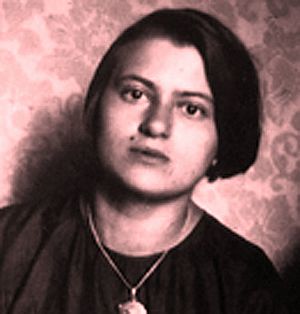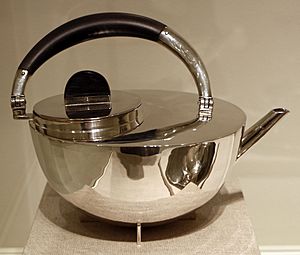Marianne Brandt facts for kids
Quick facts for kids
Marianne Brandt
|
|
|---|---|
 |
|
| Born |
Marianne Liebe
1 October 1893 Chemnitz, Germany
|
| Died | 18 June 1983 (aged 89) Kirchberg, Saxony, Germany
|
| Education | Bauhaus (Weimar School) |
| Known for | industrial design, painting, sculpture, photography |
| Spouse(s) | Erik Brandt, 1919-1935 (divorced) |
Marianne Brandt (born October 1, 1893 – died June 18, 1983) was a talented German artist. She was a painter, sculptor, photographer, and designer. Marianne is best known for her work with metal and for creating everyday objects.
She studied at the famous Bauhaus art school in Weimar, Germany. Later, she became the head of the metal workshop at Bauhaus in Dessau in 1928. Today, her designs for things like lamps and ashtrays are seen as classic examples of modern industrial design. She also made interesting pictures called photomontages.
Contents
About Marianne Brandt
Early Life and Education
Marianne Brandt was born Marianne Liebe in Chemnitz, Germany. Her family was well-known in the area. From 1911 to 1917, she studied painting and sculpture. She went to the Weimar Saxon Grand Ducal Art School.
In 1919, she married Erik Brandt, who was a Norwegian painter. They lived abroad for two years. First, they spent a year in Norway. Then, they traveled to Paris and the south of France to study art.
Joining the Bauhaus School
Marianne Brandt joined the Bauhaus school in January 1924. Bauhaus was a very important art and design school in Germany. She took classes with famous artists like Josef Albers, Wassily Kandinsky, and Paul Klee.
In the summer of 1924, she joined the metal workshop. This was a big step because it was mostly men working there. Her teacher was László Moholy-Nagy, a Hungarian artist and designer. Marianne quickly became his assistant.
Breaking Barriers in the Metal Workshop
Even though Bauhaus said it welcomed everyone, there was still a lot of gender bias. It was hard for women to get into certain workshops. László Moholy-Nagy was very impressed by Marianne's hard work. He gave her a place in the metal workshop.
She became the only woman to earn her degree from that workshop. At first, some male students thought women didn't belong there. They gave her boring tasks. But over time, they learned to work well together. When Moholy-Nagy left Bauhaus in 1928, Marianne took over as the acting director of the workshop. Many people see her as a pioneer for showing that women could succeed in the arts.
Working After Bauhaus
After leaving Bauhaus in 1929, Marianne Brandt moved to Berlin. She worked for Walter Gropius, who was the founder of Bauhaus. From 1929 to 1932, she was the head of design at a factory called Ruppel Metal Goods in Gotha, Germany. However, she lost her job because of the Great Depression. This was a time when many people lost their jobs and money.
In 1933, the Nazi period began in Germany. Marianne tried to find work outside the country. But she had family duties that called her back to Chemnitz. It was very hard for her to find steady work during this time. In 1939, she joined the "Reichskulturkammer". This was the Nazi government's official artists' group. She joined so she could get art supplies, which were otherwise forbidden. However, Marianne Brandt was never a member of the Nazi Party. She and Erik Brandt officially divorced in 1935.
Later Life and Legacy
After World War II, Marianne stayed in Chemnitz. She helped rebuild her family's home, which was badly damaged. She lived the rest of her life in East Germany. She died in Kirchberg, Saxony, when she was 89 years old.
She also taught art. From 1949 to 1951, she was a lecturer at the Dresden Academy of Fine Arts. She also taught at the Academy of Applied Art in Berlin from 1951 to 1954.
Marianne Brandt's Work
Industrial Design and Household Objects
Marianne Brandt's designs for metal ashtrays, tea and coffee sets, and lamps are very famous. They are considered some of the best designs from the Weimar and Dessau Bauhaus periods. Many of her designs were mass-produced. This means they were made in large numbers for many people to buy. Some of her designs are still made today as reproductions.
In 1926, Marianne moved with the Bauhaus school to Dessau. A year later, she became in charge of lighting design in the metal workshop. She was the director from 1928 to 1929. She spent a lot of her time designing lights.
One of her early projects was the ME78B hanging lamp (1926). This elegant lamp was made of aluminum. It had a simple saucer shape and a clever pulley system. This allowed people to easily change the lamp's height. This lamp was used in many places at the Dessau Bauhaus campus.
Photomontages and Photography
Starting in 1926, Marianne Brandt also created many photomontages. These are pictures made by combining different photographs. Most of these works were not known to the public until the 1970s.
Marianne Brandt is also remembered as a pioneering photographer. She created experimental still-life pictures. But her self-portraits are especially striking. These often show her as a strong and independent "New Woman" of the Bauhaus. Other pictures show her face and body reflected and distorted in shiny metal balls. This created a mix of herself and the metal she worked with. Marianne was one of the few women at Bauhaus who chose not to work in fields like weaving or pottery, which were often seen as more "feminine" at the time.
During the 1930s and 1940s, Marianne lived a quiet life. She continued to create art, especially paintings. She used watercolors and tempera, which were cheaper and quicker to use. Her paintings sometimes showed sadness, which is understandable given the difficult times she lived through.
Tea Sets
Marianne Brandt's tea sets are famous for their simple, geometric shapes. They were inspired by art movements like Constructivism and De Stijl. Her designs had very little decoration. The sets were made from materials like silver plate and brass, with ebony wood for the handles.
Even though the first tea sets were made by hand, they led to many similar products being mass-produced. In 1985, an Italian company called Alessi was given the rights to make reproductions of Brandt's original 1924 tea set. They also make her 1926 ashtray design with a removable lid.
Her tea set designs show the early ideas of modern art. The shape of the object was more important than adding decorations. They also looked like they could be easily made in factories.
Exhibitions
- Tempo, Tempo! The Bauhaus Photomontages of Marianne Brandt, was a traveling exhibition. It was shown at the Bauhaus Archive in Berlin, the Busch-Reisinger Museum at Harvard University, and the International Center of Photography in New York from 2005 to 2006.
See also
 In Spanish: Marianne Brandt para niños
In Spanish: Marianne Brandt para niños


